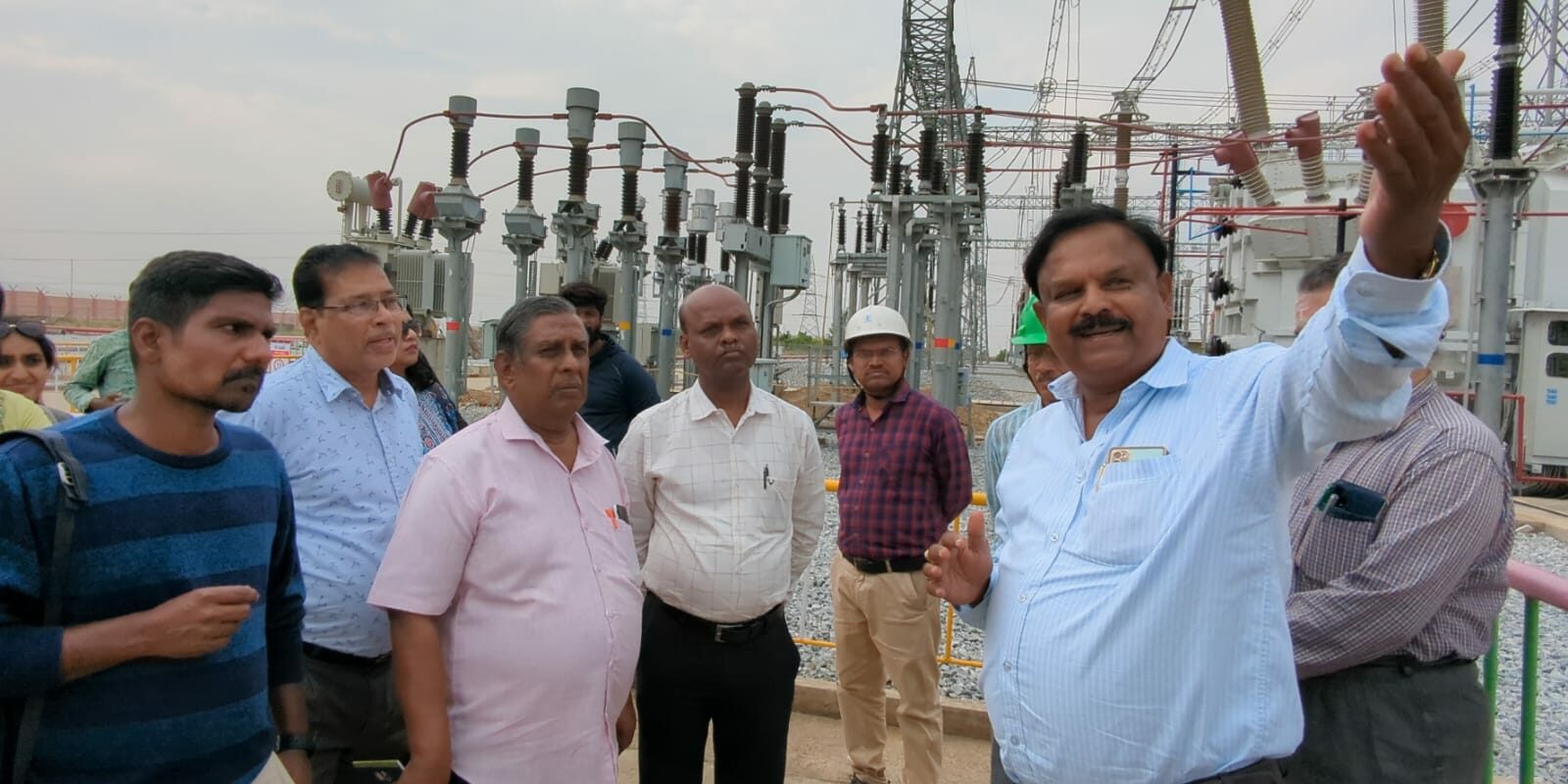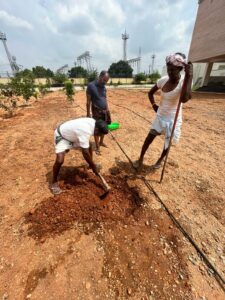The solar park has a current capacity of 2,000 MW, but there are plans to add another 300 MW to it in a few years.

The officials detailing about the operations in the solar park in Pavagada. (South First)
Nestled in the sun-drenched landscape of the Tumakuru district of Karnataka, the Pavagada Solar Park in the taluka of the same name stands as a testament to India’s renewable energy ambitions.
Once the largest, it is today the world’s third-largest solar park, with a capacity of 2,050 MW.
Beyond its technological feat, the project has brought about socio-economic transformation in a once-distressed region, making Pavagada a beacon of progress.
As the solar park gears up for an ambitious Phase 2, what unfolds is a remarkable saga of collaborative efforts, ethical practices, and a vision for a sustainable future.
If the government implements the second phase by 2025, Pavagada will reclaim the top position in the world in solar power production.
Karnataka needs 42 percent of its energy from clean resources. The total energy generation is around 71,000 million units from thermal, nuclear, large hydro, and renewable energy (RE) sources.
Combining major hydro with RE, almost 64 percent of the total capacity is from clean sources of power. The state apparently has an installed capacity of up to almost 31.7 GW from large hydro and RE sources.
Though several farmers have rued giving their land for the project for the next two decades, they are thankful to the government for commissioning the project as it is ensuring regular income annually, coupled with employment opportunities in Karnataka Solar Power Development Corporation Limited (KSPDCL) and solar parks.
KSPDCL Chief Executive Officer (CEO) N Amarnath recently shared insights into the inception and realisation of this project.
A joint venture was formed in March 2015 between the Solar Energy Corporation of India (SEIC) and the Karnataka Renewable Energy Development Limited (KREDL), an entity solely owned by the Karnataka government.
Amarnath said the KSPDCL played a pivotal role in identifying suitable lands for the solar park.
“When we invited expressions of interest, we got expressions of interest from Ballari, Tumakuru, Savadatti, and Haveri. But the maximum number of expressions of interest at a single concentrated area was received from Nagalamadike Hobli of the Tumakuru district,” he explained.
The initial plan was for a 1,000-MW park. The decision to scale it up to 2,000 MW was driven by the response. Another 50 MW was decided to be added later.
To facilitate the operation and maintenance of this solar park, it was strategically divided into 44 blocks, comprising 40 blocks of 50 MW each, and two blocks each of 10 MW and 15 MW.
Amarnath detailed the meticulous process of land acquisition, involving lease agreements spanning thousands of acres and partnerships with around 1,900-2,000 farmers as stakeholders.
The Union Ministry of New and Renewable Energy (MNRE) recognised KSPDCL as a nodal agent, empowering it to oversee infrastructure development, layout design, land creation, and the construction of essential components.
Amarnath also noted, “The biggest advantage was that before the setting up of the solar park, the buyers were already there. It was decided that 90 percent of the power generated from Pavagada Solar Park would be taken by the distribution companies of Karnataka’s energy supply companies (ESCOMs).”
He said various agencies were involved in the tendering and commissioning process, culminating in the successful completion of the entire 2,000 MW by December 2019.
The CEO underscored the comprehensive approach, including the establishment of the additional 50-MW solar plant by joint-venture partner KREDL.
“Overall, the entire 2,050-MW capacity was commissioned in December 2019,” said Amarnath.
Amarnath proudly said the choice of Pavagada for the solar park was strategic in nature.
He cited the region’s abundant solar radiation with an average of 5-6 units per square metre per day — a crucial factor in maximising energy production.
Beyond the environmental benefits, the project reportedly addresses the local community’s needs, providing employment opportunities and transforming Pavagada — already declared the most backward taluka of Karnataka — into a picture of progress.
Amarnath also noted, “The landowners willingly contributed to the project, motivated by the promise of both financial returns and the positive impact on their communities.”
He shared insights into the planning and execution of the project, detailing the land lease and sublease agreements with solar power developers and the collaborative efforts with entities like the NTPC, the KREDL, and the Solar Energy Corporation of India (SECI).
The project did face challenges, such as commissioning delays due to fluctuating market prices. However, it managed to achieve an annual generation of almost 375 million units, contributing significantly to the region’s power needs.
Amarnath also gave an overview of the investments made by various stakeholders, including the KSPDCL, solar power developers, and PGCIL.
When this green energy project was commissioned in Pavagada, it was the world’s largest solar park. Now it has slipped to third place after Rajasthan and China.
Amarnath noted, “Our solar power park, since its commissioning, remains the world’s largest concentrated in a single area, spanning just five villages within the Thirumani and Vallur Gram Panchayats. Thiruvani Gram Panchayat includes Thirumani and Rayacherlu, while Vallur GP encompasses Ballasamurdra, Vallur, and Kuathagancherlu villages.”
He added, “Additionally, our load centre at the Devanahalli Hardware Park, featuring a 220-KV gas-insulated station in the international airport area, powers Bengaluru International Airport directly from the Pavagada Solar Park.”
The CEO also said: “While Rajasthan’s Bhadla currently tops the charts with a capacity of 2,245 MW, closely followed by China’s Huanghe Hydropower Hainan Solar Park at 2,200 MW, Pavagad stands as the third-largest solar park worldwide, boasting a capacity of 2,050 MW.”
He also revealed ambitious plans: “We aim to expand our capacity by an additional 300 MW, with projects already in the pipeline. IRCON Renewable Power Ltd is set to contribute around 500 MW, and SECI has plans for 300 MW in the north, specifically in Ramagiri.”
He added: “We are also exploring land facilitation agreements in the Raptey Gram Panchayat and its surrounding areas.”
In a groundbreaking endeavour, the KSPDCL is eyeing the coveted title of the world’s largest solar park for the project by the end of 2025.
CEO N Amarnath stated, “There are three schemes in Phase 2. One is the expansion of the existing solar park by another 300 MW, bringing the total capacity to 2,351 MW.”
He added: “This expansion will occur through tariff-based competitive bidding in the existing 1,200 acres of unallocated land at Pavagada Solar Park.”
Amarnath continued, “Next, we envision setting up a 500 MW solar park, inviting solar developers to establish plants for captive, group captive, as well as third-party sales. We’re actively seeking corporate participation, exploring the allocation of 2,000 acres in a different area, with expressed interest from Raptey GP.”
Highlighting the growing interest from Central public sector units, he said, “We’ve received requests from NTPC, IOC, and others. Therefore, we’ve initiated an expression of interest for approximately 10,000 acres, leased for this purpose.”
In a bid to engage local stakeholders, Amarnath shared, “After a recent meeting with local farmers in the Raptey GP area, our optimism has risen. We are hopeful of reaching the target of 10,000-12,000 acres, including Annadanaparaah in the Thirumani GP Panchayat.”
Summing up the comprehensive plans for phase two, he concluded, “There are three schemes. One is expanding the current solar park, the second is establishing a 500-MW group captive system for corporate sales, and the third is creating a 2,500-MW solar park for Central PSUs like NTPC and IOC.”
He added: “The second phase requires approximately 14,000 acres, with 1,200 acres already secured, and the estimated investment is ₹4 crore per MW.”
The KSPDCL is also undertaking comprehensive Corporate Social Responsibility (CSR) programmes in Pavagada.
It has established a Local Area Development Fund with a corpus of ₹102.5 crore over five years from solar power developers.
Of this, ₹89.5 crore has been earmarked for various developmental projects, with 80 percent dedicated to the upliftment of affected areas. Notably, infrastructure projects such as schools, colleges, and roads are pivotal in these regions.
Directly, over 1,600 individuals are employed, spanning skill categories. Furthermore, KSPDCL’s organisational chart has 200 positions, with a focus on engineering roles.
The KSPDCL reportedly achieved sustained profitability since 2018-19.
Meanwhile, a dedicated committee chaired by the KSPDCL’s leader and featuring the SECI’s director of finance oversees the initiatives.

Three persons who gave their farmland for the Pavagada Solar Park working as gardeners in the premises of KSPDCL. (South First)
Over 3,000 farmers in and around Pavagada — an area historically plagued by severe drought — have entered into a transformative agreement with the state government, relinquishing their lands for lease for about 28 years to set up the solar power park.
This decision resulted in the cessation of traditional farming practices for hundreds. However, the farmers, are apparently content with the Karnataka government’s move to take the lands on lease instead of purchasing.
Shayamanna (name changed) told South First: “Ever since we leased our lands to the state government for the solar power project, most of the farmers are financially stable.”
He noted: “As per the agreement, the government will escalate the lease amount by 5 percent once every two years.”
He added: “In the beginning, we agreed to ₹21,000 per acre for a year. Now, it has been increased to 25,000 per acre. I have given three acres for the project.”
Shayamanna, however, regrets distancing himself from farming activities. He currently works as a gardener in the KSPDCL office premises for a monthly wage of ₹12,000.
Rangappa (named changed), who was a farmer before giving his two acres of land to the government, pointed out: “This was barren land. Though we could grow a few crops, the yield was not overwhelming due to poor rains.”
He explained: “Now, we are getting regular income annually and the government has also provided several jobs, like gardeners and security guards. We have not faced any issues since the commission of the solar park. In the last decade, we have witnessed a sea of development works.”

May 18, 2024

May 18, 2024

May 18, 2024

May 18, 2024

May 18, 2024

May 18, 2024